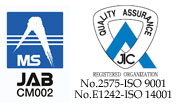The following are some examples of inquiries we have had from our customers.
For inquiries not posted here, please feel free to consult us.
Q.How much hardness can SKD-61 gain?
It can gain up to around HRC53 to 56 although it depends on the size of the product.
Q.Is it possible to quench a product with
the size H 20 x W 50 x L 1,000 and in SKD-11?
Could you specify the proper name of high speed tool steel because there are various kinds?
Q.Can you tell me the delivery time of high speed tool steel?
Yes, it is possible.
However, it is safer to review the drawing or specifications first before answering (including polishing allowance and delivery time), because the flat surface and sides of the product may experience distortion.
Normally we can treat within 3 to 4 days though it depends on the size.
Q.How much does it cost to treat 1,000 pieces of
SCM435 (structural alloy steel) Φ10 x 30 in size and HRC35 to 45?
Could you please show us the drawing first? (Heat treatment is possible.)
I will discuss with sales department to provide a sales quotation.
Q.Why did heat treated SKS (alloy tool steel) crack when I was wire cutting it?
Could you please specify the quenching and tempering conditions (with perhaps an inspection sheet)? In a wire cutting process, the processing heat reaches 300 to 350°C momentarily, so we recommend tempering at 400°C or above depending on the required hardness.
Also, another option is to change the material.
Q.I forgot to bore the product. Can you soften it back? (quenched SKD-11)
Yes, we can with annealing. (Softening the hardness)
However, the product needs to be quenched and tempered after the boring process.
If the product is already finished (with polishing, etc.), the dimensional change at the requenching process should be taken into consideration.
Q.Does sub-zero treatment suppress distortion?
No, sub-zero treatment does not suppress distortion.
To suppress distortion, it is more effective to anneal materials before machining or perform stress relief annealing before heat treatment to remove internal stress. (not perfect but effective)
The main objective of sub-zero treatment is to reduce dimensional instability, although it does raise hardness as well.
These days it is not rare to see a customer requesting high temperature tempering 3 times (one of them is for stabilization treatment) after quenching and sub-zero treatment (super sub-zero treatment).
Treatment temperature varies according to the material, but this is a popular treatment pattern used for precision parts.
